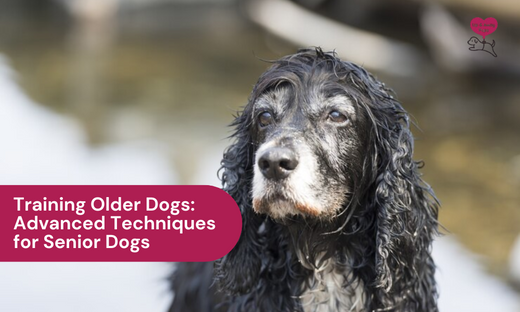Training Older Dogs: Advanced Techniques for Senior Dogs
Training older dogs is not only possible but highly beneficial for their mental stimulation and overall well-being. Discover practical tips to help your senior dog thrive!
A wonderful change that can be observed within society is the rise in the adoption of older dogs. A survey conducted by the Grey Muzzle Organization shows there is a rising interest in adoption, with 80% of individuals surveyed being open to the idea of adopting a senior dog. This is a fantastic step in the right direction. However, one of the major mental barriers individuals face when thinking of adoption is believing the myth behind the old saying that “old dogs don’t learn new tricks.” In this blog post, we’ll separate fact from fiction and lay out ways of training older dogs successfully, covering all the basics.
Why Train Older Dogs?
Dog training is a lot like exercise; it is effective and recommended at all stages of life. For senior dogs, it provides much-needed mental stimulation and keeps their brains sharp. Additionally, it actually, indirectly, strengthens the bond between you and your dog. Unlike humans, dogs don’t perceive the term “training” the way we do; they’re simply spending time with their human. Senior dogs can come either trained or untrained. If your dog already has the basics down, fantastic! If not, they might have certain behaviors or habits that need to be changed, which further necessitates the need for training to improve their quality of life.
The old saying “old dogs don’t learn new tricks” is a myth related to dogs. However, the reason this myth came into existence is because older dogs require different training than puppies and younger dogs. They often already have established habits, some of which may require high levels of patience and consistency to change. With that said, some belly rubs and treats, along with a consistent schedule, will generally be enough of a motivator.
Quick Senior Dog Training Tips
Before we begin, let’s be clear about the fact that training older dogs can pose a bit of a challenge, so here are some really quick tips to keep in mind:
1. Patience and consistency are key. Picking up or changing established behavioral patterns tasks time.
2. Be empathetic towards your dog’s physical and mental limitations. Senior dogs can sometimes suffer from anxiety as well as conditions limit them physically.
3. Keep the training session fun and enjoyable. Make use of treats, toys, and praise to keep the dog motivated. They may be older, but our dogs are puppies on the inside.
How to Crate Train an Older Dog
Crate training for an older dog can be more challenging than training a puppy, but it is equally as important. Many times, these dogs are rescued, and it takes a while for them to adjust to a new environment. The crate almost becomes their safe space during that stressful period of time, till, of course, they get familiar with the new area and people and get out. Further, it is also quite beneficial when traveling or when you have to leave the dog alone for some time at home. In order to be successful with your efforts, you must create a positive association with the crate, especially if they have never used one before. Here’s how we recommend one should go about the crate training process:
1. Start Slow and Make the Crate Comfortable: The crate, during the first time the dog sees it, both excites and scares them. The introduction needs to be slow and positive. It needs to feel inviting, so their natural curiosity drags them inside. Place soft bedding, a toy, and perhaps some treats to tempt the dog into exploring this crate. Don’t push it if they don’t take interest in it; leave the door open and allow them to take things at their own pace.
2. Use Positive Reinforcement: Positive reinforcement is here to save the day again. Whenever your dog enters the crate or shows interest in it, reward them with treats and praise. This creates a positive association with the crate. Gradually close the door for short periods while your dog is inside, and reward them for staying calm. Over time, you can increase the length of time they spend in the crate.
3. Be Patient and Consistent: You mustn’t lose patience. Senior dogs can often test you by being stubborn. Do not use the crate as a punishment, as it will only create negative associations with it. Keep the training sessions brief at first and slowly build up the training time.
4. Consider Health Issues: As is natural with age, older dogs may suffer from health conditions that make crate training more difficult than usual, such as arthritis or incontinence. If such is the case, make sure the crate is physically accessible and comfortable.
How to House Train an Adult Dog
Let us clarify first: if you were looking for how to potty train an older dog, it is the same thing as house training; both refer to the same process of teaching a dog to eliminate inappropriate places.
It may initially come as a surprise that a senior or adult dog may not come potty trained, but due to the incompetence of previous owners or numerous other factors, the dog may not have learned this very basic skill. Don’t fret, though—it can be done quite effectively with the right technique and some patience.
Before we begin listing out the ways you can house-train your senior dog, it is best to ensure they do not suffer from any medical conditions that can cause hindrance. Many times, due to age or even abuse in some cases, dogs can experience loss of bladder and bowel control. Furthermore, conditions like urinary tract infections, bladder stones, or incontinence can further complicate things, so a visit to the vet before starting the training is highly recommended.
Establish a Routine
House training will take patience and consistency; those are the two keys here. Take your dog outside at regular intervals throughout the day, such as in the morning, after meals, and before bedtime. Establishing a routine will help your dog understand when it’s time to go. Also, be proactive.
Use a Crate
Crate training can also help with house training. A dog’s instinct is to keep their sleeping area clean, so confining them to a crate when you cannot supervise them directly can prevent accidents inside. When you let your dog out of the crate, immediately take them to their designated potty area. This helps reinforce the connection between being outside and relieving themselves so it's best to crate them first.
Reward for Success
Positive reinforcement plays a crucial role in house training. Whenever your dog goes outside to relieve themselves, reward them with treats, praise, and affection. This lets them know that going outside is the right behavior. Consistency in rewarding them for good behavior will help solidify the habit.
Be Patient with Setbacks
Senior dogs may have accidents in the house, and it is okay. Do not punish or scream at them for it. If and when these older pups have an accident inside the house, clean the area thoroughly, let them know you’re disappointed in a calm manner, and try to continue reinforcing the appropriate potty training behavior. Over time, your dog will understand when and where to go.
Leash Training an Older Dog
If you take your dog out for a walk, and they’re the ones leading the way—dragging you from one tree to another, pulling every time they see another dog, person, or, God forbid, a squirrel—are you really the one walking the dog, or is the reverse more appropriate here? Remember that a walk with your dog should be relaxing, not a constant tug-of-war. And older dogs can surprise you with their strength.
Leash training an older dog requires patience and positive reinforcement. Many senior dogs have already established leash habits, which may need to be adjusted, but with the right approach, leash training can still be successful.
1. Start Slowly: Begin by letting your senior dog get used to wearing a leash and collar if they haven’t before. Let them wear the leash indoors while supervised so they can get comfortable with it. Do not pull on the leash and instead allow your dog to explore while attached to the leash. Remember that older dogs can suffer from serious discomfort if their leash is pulled too hard.
2. Teach Basic Commands: Before venturing to the great outdoors, teach your dog basic commands like “sit,” “stay,” and “heel” indoors or in a controlled environment in order to make outdoor walks more manageable. Be sure to reward them with treats and praise when they follow commands correctly.
3. Practice Short Walks: Once your dog is comfortable with the leash, start with short walks around your yard or inside your home. Keep the walk slow and relaxed, allowing your dog to explore at their own pace and encourage them to walk beside you, rewarding them when they stay by your side.
4. Gradually Increase the Walk Distance: As your senior dog becomes more comfortable with the leash, you can gradually increase the length of your walks. Take them to new places, but keep the pace slow. Be mindful of your dog’s energy levels and physical condition, as older dogs may tire more quickly than younger ones. Take breaks when necessary and track how long and further they can walk comfortably.
Conclusion
Older dogs deserve as much love and care as any other dog. Age really is just a number with these furballs. Many times, what keeps individuals from adopting a senior dog is the paranoia or misconception that they cannot be trained, which is far from the truth. With the right technique, patience, love, and care, your senior dog can and will adapt to your lifestyle and live a happy and healthy life.


